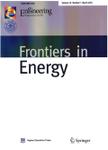Preliminary experimental study of a supercritical CO2 power cycle test loop with a high-speed turbo-generator using R134a under similarity conditions
Preliminary experimental study of a supercritical CO2 power cycle test loop with a high-speed turbo-generator using R134a under similarity conditions作者机构:Thermal Energy System Laboratory Korea Institute of Energy Research 152 Gajeong-ro Yusung-gu Daejeon 34129 Republic of Korea Engine Component Research Team Korea Aerospace Research Institute (KARl) 169-84 Gwahak-ro Yusung-gu Daejeon 34133 Republic of Korea InGineers 21 Saman-ro 16 Beon-gil Gimhae-si Gyeongsangnam-do 621-220 Republic of Korea
出 版 物:《Frontiers in Energy》 (能源前沿(英文版))
年 卷 期:2017年第11卷第4期
页 面:452-460页
核心收录:
学科分类:08[工学] 0813[工学-建筑学] 0814[工学-土木工程]
基 金:the framework of Research and Development Program of the Korea Institute of Energy Research (KIER) supported by the On Demand Development Program of Core Technology for Industrial Fields funded by the Ministry of Trade, Industry & Energy (MI, Korea)
主 题:supercritical CO2 power cycle turbomachin-ery compressor turbine
摘 要:Research on applying a supercritical carbon dioxide power cycle (S-CO2) to concentrating solar power (CSP) instead of a steam Rankine cycle or an air Brayton cycle has been recently conducted. An S-CO2 system is suitable for CSP owing to its compactness, higher efficiency, and dry-cooling capability. At the Korea Institute of Energy Research (KIER), to implement an S-CO2 system, a 10 kWe class test loop with a turbine- alternator-compressor (TAC) using gas foil bearings was developed. A basic sub-kWe class test loop with a high- speed radial type turbo-generator and a test loop with a capability of tens of kWe with an axial type turbo- generator were then developed. To solve the technical bottleneck of S-CO2 turbomachinery, a partial admission nozzle and oil-lubrication bearings were used in the turbo- generators. To experience the closed-power cycle and develop an operational strategy of S-CO2 operated at high pressure, an organic Rankine cycle (ORC) operating test using a refrigerant as the working fluid was conducted owing to its operational capability at relatively low- pressure conditions of approximately 30 to 40 bar. By operating the sub-kWe class test loop using R134a as the working fluid instead of CO2, an average turbine power of 400 W was obtained.



